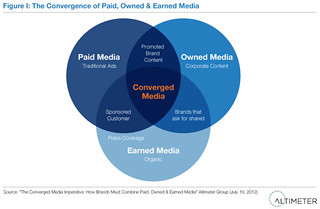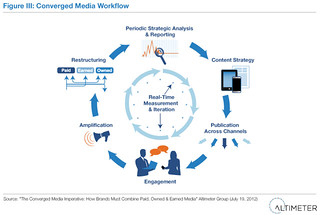To join in an active discussion and presentation, co-author Rebecca Lieb and myself will be hosting a webinar convering the findings from the research, please register for the webinar on Converged Media. Altimeter directly interviewed 34 agencies, brands, technology vendors and industry experts to answer how media are changing. we found:
Summary: Converged Media a Reality –Significant Ecosystem Changes Ahead
Paid, owned, and earned is converging (like social ads) at a rapid pace, we found 11 criteria of success, a handful of case examples, yet companies are hampered internally and with fragmented agencies and technology to make this happen. Converged Media utilizes two or more channels of paid, earned, and owned media. It is characterized by a consistent storyline, look, and feel. We foresee that to achieve cross-channel integration in a consistent way there will be considerable changes inside of the marketing org chart, and a clear strategy on getting agencies to collaborate, and intensive system integration of vendors.
Open Research: Use, Share, and We’ll Create More
Altimeter practices Open Research, we provide our research to you, and encourage you to use with proper licensing as outlined by Creative Commons. Also, we believe in transparency in financial relationships of the companies which we covered in this report, and disclose our relationships if allowed. If you found this report useful, please actively share, which helps us to generate energy to create more.
Report Highlights
- Overview of needs, market definitions, overview of brands, agencies, and software providers.
- Three framework graphics ideal for powerpoint: Converged Media venn, use case workflow, criteria checklist.
- Checklist of 11 criteria required for converged media success.
- Four real world case studies bringing this concept to life from four leading brands.
- Pragmatic recommendations for marketing leaders for internal needs, agency strategy, and vendor deployment.
- Vendor showcase of ten technology providers who are seeking to solve this opportunity.
My focus over the past years have been owned corporate content (owned) and social (earned), however my viewpoint on the paid side has been limited. Thankfully, I was able to partner with Altimeter’s Rebecca Lieb who hails from Manhattan and has a strong background in advertising, search, (paid) and corporate content (owned), together with researcher Jessica Groopman and editor Chris Silva, we sought out to answer these questions and bring multiple perspectives together.
At the bottom of this post, I’ll cross-link to all thoughtful conversations, extending the conversation, below the report is embedded directly below:

Above: Today, advertising, corporate content, and social content is often separated, but tomorrow, we expect these circles to converge and overlap, with little or no separation. Hence the term “Converged Media”. We deliberated at great length on how these items would be properly fit into this framework, and

Above: Although we expect many workflows to emerge, this pattern became evident within interviews. In particular, we frequently heard that analysis of social content was often a precursor to content creation by the brand. Furthermore, very few technology providers will be able to solve this entire use case, and brands and agency partners will be relegated to system integration and methods to coalesce.

Above: 11 Success Criteria to Make Converged Media a Reality: We found through interviews a set of patterns from respondents on what will make this a reality and organized the criteria into four distinct categories: Strategy, Organization, Production, Analysis. While this process is likely followed in any individual point channel, now, it must be an integrated approach
Related Discussions
- There’s a churning discussion on Twitter using tag #POEMedia
- Co-Author Rebecca Lieb has posted at her blog, and cross-posted on the Altimeter blog
- Rallyverse folks have written a Haiku to the challenges and aspirations of Converged Media
- Search Engine Watch gives a review of the report
- J-P De Clerck published a review on Conversionation
- Augie Ray posted on the Experience blog, read his thoughtful review
- Nick Cicero gives two requirements for POE to converge
- Geoff Livingston gives a thoughtful review and offers an honest critique
- BL Oshman covers how on media convergence a wake-up call to lagging brand –but says this is not new information
- Dana Oshiro at Netshelter covers the report
- Paul at the Cision blog asks if “Paid Owned Earned” has become a buzzword
- Nick Burcher has published a blog and book called “Paid Owned Earned” which I read as background.
- Software vendor Thismoment shares a review
- The Extole blog shares the report, and highlights importance of convergence
- Loena says the needs are real and challenges are even greater to converging media
- Shel Holtz gives insights on the struggle between distributed and centralization
- Deep focus covers the report, who participated in the research process
- Maggie Fox says Paid Owned and Earned are “Dead”
- Flat World Buzz reviews the report
- Xochi of CDS Global says invest in the trifecta but observes that brands focus on owned.
- Liveworld CEO Peter Friedman gives his perspective on converged, and sees that earned is leading –but makes public confirmation towards paid
- Converged Media by Dreamglow
- Great review which even critiques the report case study, and also provides actionable recommendations
- Flatworld buzz reviews the report
- Daniel Joerg shares the report in his weekly wrapup
- MediaPost covers the report, but from a search perspective
Thanks for shearing this, your converged media concept is truly awesome.